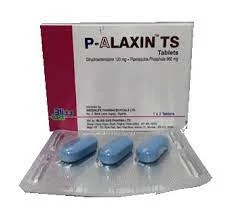P-alaxin TN And Suspension Dose, Side Effect, Indication, Composition
P-alaxin is an Artemisinin-based combination therapies (ACTS). It contains dihydroartemisinin and piperaquine. It is used in the treatment of uncomplicated malaria.
The Artemisinin derivative is extracted from Artemisia Annua, a traditional Chinese medicinal plant and an antimalarial drug, piperaquine.
P Alaxin is a product of Bliss GVS Pharma Ltd and marketed by Greenlife Pharmaceutical. It has proved effective in the treatment of uncomplicated Plasmodium falciparum malaria. It has been evaluated in clinical trials in adults, children and infants of 6 months and over.
Read Also: Treatment for malaria in children
Composition Of P-alaxin
Composition Of P-alaxin B (12, 9, 6 and 3 Tablet)
Each films coated tablet contains:
Dihydroartemisinin 40 mg
Piperaquine 320 mg
Excipients q.s
Color: brilliant blue, Indigo carmine and titanium dioxide
Composition Of P-alaxin TS (3 Tablet)
Each films coated tablet contains:
Dihydroartemisinin 120 mg
Piperaquine 960 mg
Excipients q.s
Color: brilliant blue, Indigo carmine and titanium
 |
| P-alaxin TS |
Composition Of P-alaxin Suspension
Each 80 ml suspension after reconstitution contains:
Dihydroartemisinin 80 mg
Piperaquine 640 mg
Excipients q.s
Color: sunset yellow FCF
Pharmacology And Pharmacokinetics Of P-alaxin
Dihydroartemisinin mainly interfere with the membrane structures of trophoizoite (erythrocytic asexual form), i.e. food vacuole membrane, distended mitochondria, swollen nuclear membrane, dissociation of ribosomes from endoplasmic reticulum leading to endoplasmic vacuolization and autophagocytosis. In addition, biochemical depression of protein synthesis and nucleic acid synthesis are exhibited.
Upon oral administration dihydroartemisinin is rapidly absorbed and maximum blood concentration attains 1 hour afterwards, with a half-life of about 4 hours. It is widely distributed in the liver, kidneys and bile. Approximately 80% is excreted through the urine and feces within 24 hrs after administration. It is metabolized to inactive metabolites, deoxy dihydroartemisinin and dihydroxy dihydroartemisinin.
Experimental results show that piperaquine phosphate (PQP) interferes with physiological function of the food vacuole membrane of the trophozoite leading to auto phagocytosis of the parasites. It has no marked effect on the ring forms, immature or mature schizont and the male or female gametophyte.
Read Also: Treatment of malaria in adults
Upon oral administration about 80 - 90% is absorbed within 24 hours. It is widely distributed in the body mainly in the liver, kidneys, lungs and spleen. About 25% of the total dose is partitioned in the liver within 8 hours of intake. Elimination is very slow with the half-life of about 20 - 22 days. It is excreted through bile by hepatoenteric circulation.
Indication And Use Of P-alaxin
Treatment of clinical attacks of malaria caused by plasmodium falciparum, plasmodium vivax and plasmodium malariae.
Dosage And Administration Of P-alaxin
Dosage of p-alaxin by 12, 9, 6, 3 tablet based on body weight in kg
11-<17: 1 tablet daily for 3 days
17-<25: 1.5 tablets daily for 3 days
25-<36: 2 tablets daily for 3 days
36-<60: 3 tablets daily for 3 days
60-<80: 4 tablets daily for 3 days
>80: 5 tablets daily for 3 days
Dosage of p-alaxin TS based on body weight in kg
36-<60: 1 tablet daily for 3 days
Dosage of p-alaxin suspension based on body weight in kg
5: 12.5 ml daily for 3 days
7: 17.5 ml daily for 3 days
10: 25 ml daily for 3 days
Children weighing <25 kg should receive at least 2.5 mg/kg dihydroartemisinin and 20 mg/kg piperaquine as per body weight to achieve therapeutic exposure. The dose should not be consumed in divided doses.
Read Also: Comparison of lonart and p-alaxin
It should be taken orally with water and without food (a gap of 3 hours between meals). For patients unable to swallow the tablets, the tablet may be crushed and mixed with water. The mixture should be used immediately after preparation.
Contraindications
P-alaxin are contraindicated in patients hypersensitive to dihydroartemisinin, piperaquine phosphate or any other excipients of the products. This product is not recommended for use in women during the first three months of pregnancy.
Warning And Precautions
Caution should be taken while administering drugs to patients with hepatic kidney impairment. Do not exceed the stated dose.
Pregnancy And Lactation
There is insufficient data on the use of the dihydroartemisinin and piperaquine in pregnant women. Based on animal data, p-alaxin is suspected to cause serious birth defects when administered during the first trimester of pregnancy.
Reproductive studies with artemisinin derivatives have demonstrated teratogenic potential with an increased risk during early gestation. P-alaxin should not be used during pregnancy in situations where other suitable and effective antimalarials are available.
Animals data suggest excretion of piperaquine into breast milk but no data available in humans. Patients who take p-alaxin should not breastfeed during their treatment.
Interaction
Caution should be taken while administering p-alaxin tablets with drugs such as inhibitors of CYP3A4, CYP2C19, rifampicin, carbamazepine, phenytoin and phenobarbital.
Read Also: Meaning of TS in p-alaxin TS
Adverse Reaction And Side Effects
1. Nausea or vomiting occupationally with incidence of less than 6%
2. No noticeable side effects of dihydroartemisinin are reported. The dihydroartemisinin would, for certain individuals, bring effect of greater or lesser severity: for example reversible reduction in reticulocyte count.
3. Possible side effects of PQP include dizziness, vertigo, headache, nausea, vomiting and abdominal discomfort. Reversible leukopenia was infrequently reported; dyspnoea and palpitations were also reported but not further specified.
Overdosage
In cases of suspected overdose, symptomatic and supportive therapy should be given as appropriate, including ECG monitoring because of the possibility of QTc interval prolongation.

My baby is 15kg, how many mls of P-Alaxin Suspension can she take
ReplyDeletea tablet of p alaxin daily is recommended. if the baby cannot swallow, give about 37 ml daily. a single bottle will not be enough
DeleteI’m reacting to the side effect , I’m itching
ReplyDeleteAlways use an antihistamine
DeleteI was scared to give 25ml to my 10kg baby I felt it's too much this just reassure me that all is well.
ReplyDelete